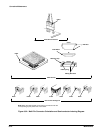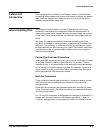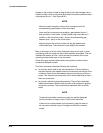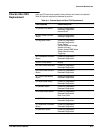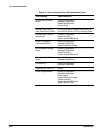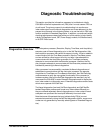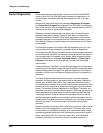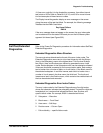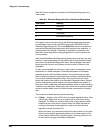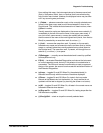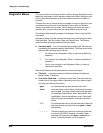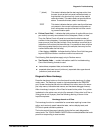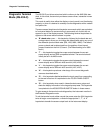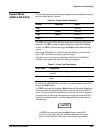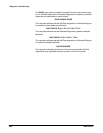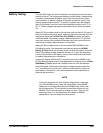
Diagnostic Troubleshooting
Maintenance
6Ć82
Table 6Ć5 lists the subsystem characters of the Extended Diagnostic error
index codes.
TableĂ6Ć5:ăExtended Diagnostics Error Index Code Descriptions
Description
Meaning
E Executive
D Display
T Time Base
m Mainframe Acquisition
Front panel controls are active during the SelfĆTest diagnostics sequence;
any disturbance may cause a test failure, forcing the CSA 803C into the
Extended Diagnostics mode. Touch the (E)Exit label twice in succession to
remove the Extended Diagnostics menu and resume normal operation. In
situations where the Display, Time Base, or Acquisition processors have
failed their kernel diagnostics, exiting diagnostics to normal operation will
not be possible.
After the SelfĆTest/Extended Diagnostic programs have executed, any resulĆ
tant error index codes appear on the display next to the associated subsysĆ
tem name in the Extended Diagnostics menu. Each subsystem that had a
failure gives the first error encountered and the number of failures in the
subsystem.
To get a more complete list of the error index codes in a subsystem, touch
the selector of a failed subsystem (if the failed subsystem is not already
selected) and then touch the Block selector. Touching the Area and then
Routine selectors shows the lowest level test routines in the selected Block.
The currently selected Subsystem, Block, Area, and Routine are shown
below their labels at the bottom of the Extended Diagnostics menu. Several
function and operating mode selectors are also available at the bottom of
the screen. When certain test routines are selected, some of these operating
modes are nonĆselectable. Additionally, when some of the operating modes
are set to certain states, some of the test routines may become nonĆselectĆ
able.
The function and mode operators are the following:
H (?)Help Ċ displays a list of FRUs for the currently selected routine. If the
routine had a failure, then the error index code for that routine is also
displayed. The FRUs are normally listed as the mostĆtoĆleast probable
cause for errors in the routine. In some cases, the FRUs are listed acĆ
cording to their easeĆofĆreplaceability in order to minimize the time
required to identify the faulty FRU.
Within this menu, you can scan forward to the next routine or to the next
failure by touching the appropriate selectors in the lower portion of the
screen (which functions like a simple keypad). Scanning continues in a
circular fashion through all available subsystems.



